You’ve probably been there - standing outside a “booked” meeting room that’s clearly empty, or walking into one that someone else has already claimed. In hybrid offices, this happens more often than it should.
That’s why meeting room booking software has become a must-have in modern workplaces. These tools make it easy to find and reserve spaces, avoid double bookings, and keep meetings running smoothly.
It’s no surprise, then, that the meeting room booking software industry was valued at around USD 74.34 million in 2021 and is expected to grow more than twofold by 2028.
In this guide, you’ll find the best conference room booking systems in 2025 - from lightweight tools for small teams to enterprise-grade hybrid workplace platforms built to manage every space, schedule, and meeting efficiently.
Click on a vendor name to jump straight to its description:
- YAROOMS
- OfficeSpace
- Deskflex
- AskCody
- Clearooms
- Robin
- Tactic
- Nexudus
- Officely
- Tidaro
- Skedda
- Matrix Booking
- Dibsido
- Smartway2
- Roomzilla
- Kadence
What Is a Meeting Room Booking System?
A meeting room booking system is a software tool that helps employees reserve and manage shared spaces like conference rooms, huddle areas, or collaboration zones. It replaces manual scheduling - such as shared spreadsheets or email requests - with an automated, real-time solution that prevents double bookings and ensures every meeting has the right space.
What are Some Examples of Meeting Room Booking Software?
Some examples of meeting room booking software include YAROOMS, OfficeSpace, DeskFlex, AskCody, and Clearooms. Each offers a different path toward the same goal - making conference room management more organized, efficient, and ready for the way we meet today. We’ll take a closer look at all of them later in this article.
How Does Meeting Room Booking Software Work?
A meeting room booking system streamlines the entire scheduling process: from finding an available conference room to analyzing space usage afterward. Here’s how it typically works:
Step 1: Employees Search for Available Conference Rooms
Users start by opening the booking platform or integrated app (like Microsoft Teams or Outlook) to see real-time room availability. Interactive office maps and search filters (capacity, equipment, location) make it easy to find the right meeting space.
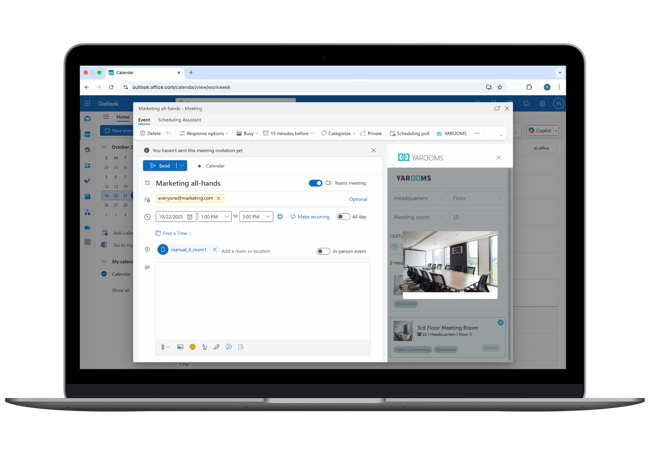
Example: searching for the available conference room with YAROOMS Outlook add-in
Step 2: They Reserve the Room in Just a Few Clicks
Once a suitable room is found, it’s booked directly through the system - no emails or back-and-forth messages needed. The booking automatically syncs across calendars so everyone sees the confirmed reservation.
Step 3: The System Confirms and Notifies Participants
The meeting room scheduler sends automatic confirmations and reminders to attendees. If needed, it can also send check-in prompts or release the room if no one arrives, ensuring efficient use of space.
Step 4: Administrators Apply Smart Rules and Policies
Facility managers can define booking permissions, time limits, and set approval workflows to keep meeting room scheduling fair and organized. Some reservation systems even connect to access control or digital signage to display current room status.
Step 5: Usage Data Is Tracked and Analyzed
Behind the scenes, the platform collects data on room utilization, peak times, and booking trends. These analytics help organizations optimize layouts, reduce underused conference rooms, and improve the overall workplace experience.
In short, by automating each step - from discovery to data - meeting room booking software saves time, prevents conflicts, and provides valuable insight into how offices are actually used.
.png?width=650&height=455&name=meeting%20room%20booking%20analytics(1).png)
Example: meeting room utilization report
Benefits of Meeting Room Reservation Software
A meeting room booking system can completely transform how organizations manage shared spaces. Below are the key benefits (backed by real data) that show why it’s a smart investment for modern workplaces.
Convenience and Accessibility
Meeting room booking systems are typically accessible through multiple interfaces - a web app, mobile app, or even a digital room panel at the door. Employees can check real-time availability and reserve spaces anytime, from any device. This always-on access supports flexible and hybrid work while eliminating the need to be on-site to book a meeting room.
Reduced Administration Overhead
Automated conference room scheduling significantly cuts down administrative workload. For example, Jigsaw Insurance, using YAROOMS, saves the equivalent of one team leader’s full-time hours (valued at £21,000 - £23,000 per year) simply by allowing employees to self-book meeting rooms, hot desks, and other office spaces.
Prevention of Double Bookings
Double bookings can cost businesses $1,800 to $4,100 per employee each year in wasted time and miscommunication. A conference room scheduling system prevents this by providing real-time updates across shared calendars, ensuring no two meetings overlap.
Efficiency Gains and Time Savings
48% of office workers waste time each week searching for available meeting rooms, losing up to 30 minutes a day. A meeting room booking system removes this friction by making availability clear and booking instant, freeing employees to focus on productive work.
Improved Collaboration
A centralized meeting room booking platform shows who’s meeting where and when, improving transparency and collaboration. It also helps teams choose rooms with the right capacity, avoiding over- or under-utilization.
Better Room Utilization and Cost Savings
With meeting rooms used only 38% of the time on average, utilization analytics and office heat maps reveal underused areas and justify layout changes or downsizing. Data-driven planning lowers real estate costs and supports smarter office design.
Check how much your organization could save by using meeting rooms more efficiently. ⬆️
Key Features to Look for in Meeting Room Booking Systems
The best meeting room booking solutions simplify scheduling, optimize space use, and integrate smoothly with your broader workspace software ecosystem. Below are the key features to look for:
Simplicity and Accessibility
An effective room management software should make scheduling simple for everyone. Look for an interface that requires minimal training, supports drag-and-drop booking, and works across multiple devices - from web and mobile apps to conference room reservation tablets mounted outside each space.
Calendar Integrations (Microsoft Outlook, Google Calendar, etc.)
Smooth room booking systems integrations are crucial. The software should connect with tools your teams already use, like Microsoft Outlook or Google Calendar to create, edit, or cancel reservations directly within their preferred environment.
Mobile Compatibility
In a hybrid workplace, mobility defines productivity. Look for conference booking apps that allow full functionality from smartphones or tablets, letting employees reserve or check availability while commuting or traveling.
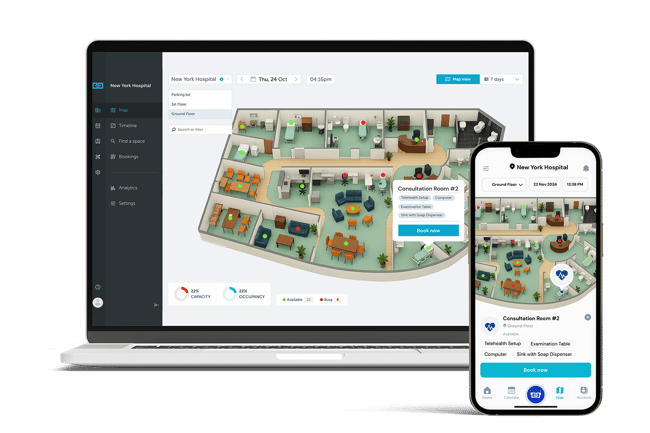
Example: room booking software available on both web and mobile apps.
Real-Time Availability Updates
A reliable space booking system should display real-time availability so employees can instantly see which rooms are free or occupied. Color-coded dashboards, occupancy sensors, and conference room reservation tablets help visualize usage throughout the day.
Notifications and Reminders
Automation transforms a simple conference room app into an intelligent scheduling assistant. Look for systems that send automatic confirmations, reminders, and cancellation alerts - and even release unused rooms if no one checks in within a set window.
Digital Meeting Room Signage
Displays outside meeting rooms can show current and upcoming bookings, capacity limits, and instant “book now” options. This makes it easy for employees to quickly find available spaces and reserve them on the spot, without opening an app or interrupting ongoing meetings.
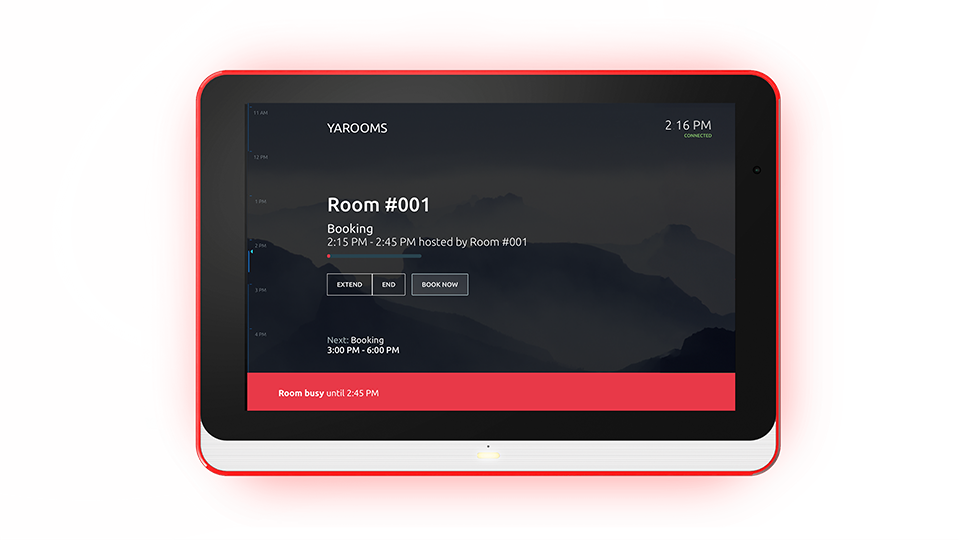
Example: digital conference room signage app
Conference Room Usage Data
A next-generation room scheduling solution should provide detailed analytics on occupancy, booking trends, and meeting frequency. These insights support smarter space planning and help determine whether to repurpose, expand, or consolidate meeting areas. They also give leaders a clear view of how space is actually used day to day - making analytics an essential factor when evaluating room booking system cost and long-term return on investment.
Security and Access Control
Security is fundamental for any online space booking tool. The conference room management software should include user authentication, data encryption, and granular access levels.
Compare the 16 Best Meeting Room Booking Systems in 2025
| Software | Key Strengths | Best For | Pricing |
|---|---|---|---|
| YAROOMS | Complete workplace platform with Microsoft 365 integration, approval workflows, service booking, analytics, and signage. | Organizations of all sizes in finance, healthcare, education, technology, and government. | $$ |
| OfficeSpace | Automated room scheduling, real-time occupancy visibility, and smart booking rules. | Mid to large organizations wanting automated scheduling and better room utilization. | Not public |
| AskCody | Deep Microsoft 365 integration with Outlook-based booking, service ordering, and dashboards. | Enterprises and professional services teams using Microsoft Outlook. | $$$ |
| Clearooms | Quick setup, custom branding, privacy mode, and Google/Outlook sync. | Small to mid-sized companies seeking affordable, easy-to-use booking tools. | $ |
| Robin | Smart space matching, mobile booking, and Slack/Teams integrations. | Medium to large companies with multiple locations needing seamless coordination. | Not public |
| DeskFlex | AI-powered scheduling, open-source calendar, analytics, and interactive maps. | Enterprises, government, and education sectors needing flexible booking control. | Not public |
| Nexudus | Custom rules, dynamic pricing, and member access control for shared workspaces. | Coworking spaces and flexible offices managing memberships and resources. | $$ |
| Tactic | One-click bookings, reminders, and analytics with clean design and quick onboarding. | Modern offices and growing teams wanting a fast, intuitive booking system. | Not public |
| Officely | Simple Slack & Teams integration, smart matching, and real-time availability. | Teams using Slack or Microsoft Teams needing a straightforward booking tool. | $ |
| Tidaro | Outlook sync, tablet mode, SSO, and ISO-certified data security. | Organizations needing a secure, Microsoft-friendly booking solution. | $ |
| Skedda | Real-time availability, analytics, and fair booking rules with calendar sync. | Businesses of all sizes needing transparent, data-driven space management. | $$$ |
| Matrix Booking | Powerful filters, multi-channel booking, and resource scheduling across sites. | Public and private organizations managing rooms across multiple locations. | Not public |
| Dibsido | One-click reservations, auto-cancel, and interactive maps with mobile booking. | Small to mid-sized offices needing simple, visual space scheduling. | $ |
| Smartway2 | Smart recommendations, integrated services, and actionable analytics. | Medium to large organizations optimizing meeting efficiency and space use. | Not public |
| Roomzilla | Unified room, desk, and equipment booking with interactive maps and displays. | Any organization seeking a single platform for all resource management. | $$ |
| Kadence | Quick booking, live data, check-in reminders, and strong support. | Modern teams needing simple, automated scheduling with real-time visibility. | Not public |
1. YAROOMS
YAROOMS is the complete workplace management platform offering end-to-end meeting room management. It integrates seamlessly with Microsoft 365, supports approval workflows, and includes service booking for catering, equipment, and other meeting needs - giving organizations everything required to plan meetings in one place.
YAROOMS: end-to-end meeting room management
Feature Highlights
-
Booking from any device: Reserve rooms anytime through the web or mobile app, digital room displays, or by chatting with YARVIS AI assistant directly in Microsoft Teams or Slack.
-
Approval workflows: Set smart approval rules by user, time, or location to keep meeting room scheduling organized and compliant with internal policies.
-
Service booking: Reserve a meeting room and request catering, cleaning, or equipment in one step, removing the need for separate requests.
-
Digital room signage: Book or adjust meetings directly from the display outside the room and instantly see real-time availability.
-
Seamless integrations: YAROOMS connects effortlessly with Microsoft Outlook, Teams, Zoom, Google Calendar, and other workplace tools for frictionless scheduling.
-
Room utilization reports: Access detailed insights on usage, occupancy, and no-shows to optimize meeting space efficiency.
-
Interactive floor plans: View available meeting rooms on an interactive office map and pick the perfect space for your team’s needs.
Click on the media for a self-guided demo of YAROOMS room booking software
Best For
YAROOMS is ideal for organizations of all sizes that need a comprehensive workplace management platform, especially those in finance, healthcare, education, technology, and government sectors.
Pricing
YAROOMS offers flexible pricing plans starting at $99/month for small teams, $399/month for growing companies, and $899/month for enterprises with advanced needs.
Customer Feedback
Positive: Users praise YAROOMS for its intuitive meeting room booking interface, easy onboarding, and seamless Microsoft 365 integration. Workplace managers value the detailed analytics that help track room usage and costs, noting clear ROI from reduced no-shows, optimized meeting space utilization, and lower administrative workload.
Negative: Some mention that YAROOMS’ feature set can feel more advanced than smaller teams require, but once configured, it’s described as reliable, scalable, and built for long-term efficiency.
| Pros | Cons |
|---|---|
| Intuitive meeting room booking interface | May feel more advanced than small teams need |
| Seamless Microsoft 365 integration | Initial setup can take time to configure |
| Powerful analytics for room usage and cost tracking | – |
| Proven ROI through reduced no-shows and optimized space use | – |
YAROOMS pros and cons
2. OfficeSpace
OfficeSpace offers a conference room booking and management system that helps teams easily find and reserve available spaces, reducing coordination hassles and keeping the workday running smoothly.
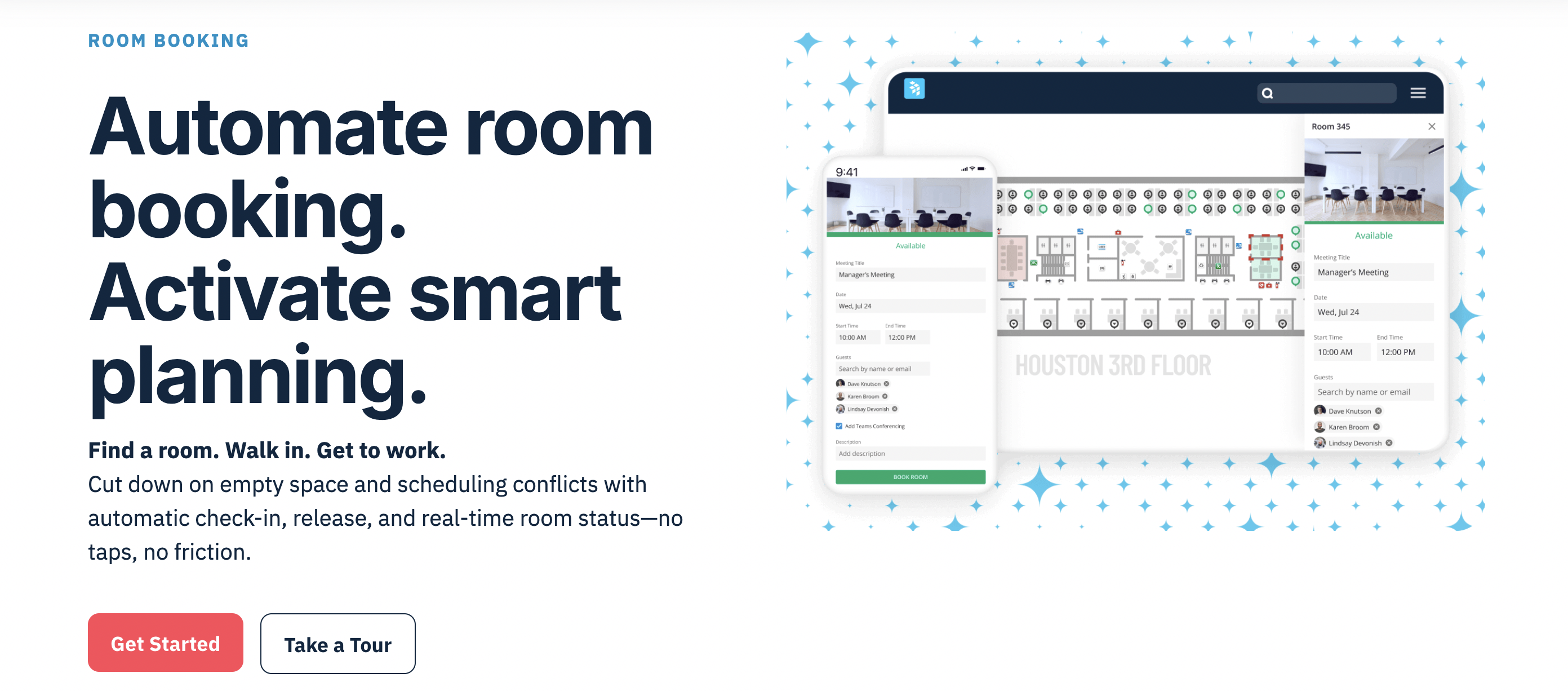
OfficeSpace: automate room booking, activate smart planning
Feature Highlights
- Walk-in reservations: Rooms are automatically booked when employees enter, removing extra steps and keeping scheduling effortless.
- Live room status: Real-time occupancy data and interactive floor plans show which spaces are in use, free, or soon to be available.
- Auto-cancel for unused meetings: Unoccupied rooms are automatically released so others can book them, reducing wasted space.
- Automated reminders and check-ins: Smart notifications remind teams of upcoming meetings and prompt check-ins, freeing up rooms when plans change.
- Custom booking rules: Set booking windows, meeting durations, and check-in policies by site, role, or room type to match how your workplace operates.
Best For
OfficeSpace is ideal for mid-sized to large organizations that want to automate meeting coordination and improve real-time visibility of room usage. It’s especially useful for hybrid workplaces looking to reduce scheduling friction and make better use of shared office space.
Pricing
OfficeSpace offers tiered plans - Lite, Essentials, and Pro - designed to fit different organizational needs. However, starting prices aren’t listed publicly, which can make initial comparison difficult for teams evaluating multiple room booking solutions. Interested buyers need to request a quote to understand the actual room booking system cost for their setup.
Customer Feedback
Positive: Users describe OfficeSpace as intuitive, reliable, and beginner-friendly. Many highlight how easy it is to configure and label workspaces, noting that the platform “just makes sense” even for first-time users. Customer support receives particular praise for being responsive, proactive, and communicative.
Negative: Some users mention minor usability issues, such as difficulty zooming in on floor plans or occasionally missing check-in prompts. Others note that certain data, like booking details, appears in separate reports, which can interrupt their workflows. A few users have also pointed out that rapid software updates sometimes introduce small, temporary bugs.
| Pros | Cons |
|---|---|
| Intuitive, beginner-friendly interface | Minor navigation issues (e.g., zooming on floor plans) |
| Excellent, responsive customer support | Pricing not publicly available |
| Easy workspace configuration and labeling | Occasional bugs after quick updates |
| Clear visibility of conference room availability and status | Some booking data stored separately from main reports |
Pros and cons of OfficeSpace
3. AskCody
AskCody is a meeting room booking platform integrated with Microsoft Outlook and Office 365. It lets users find available rooms, book meeting services, and manage visitors, all without leaving their familiar Microsoft environment.
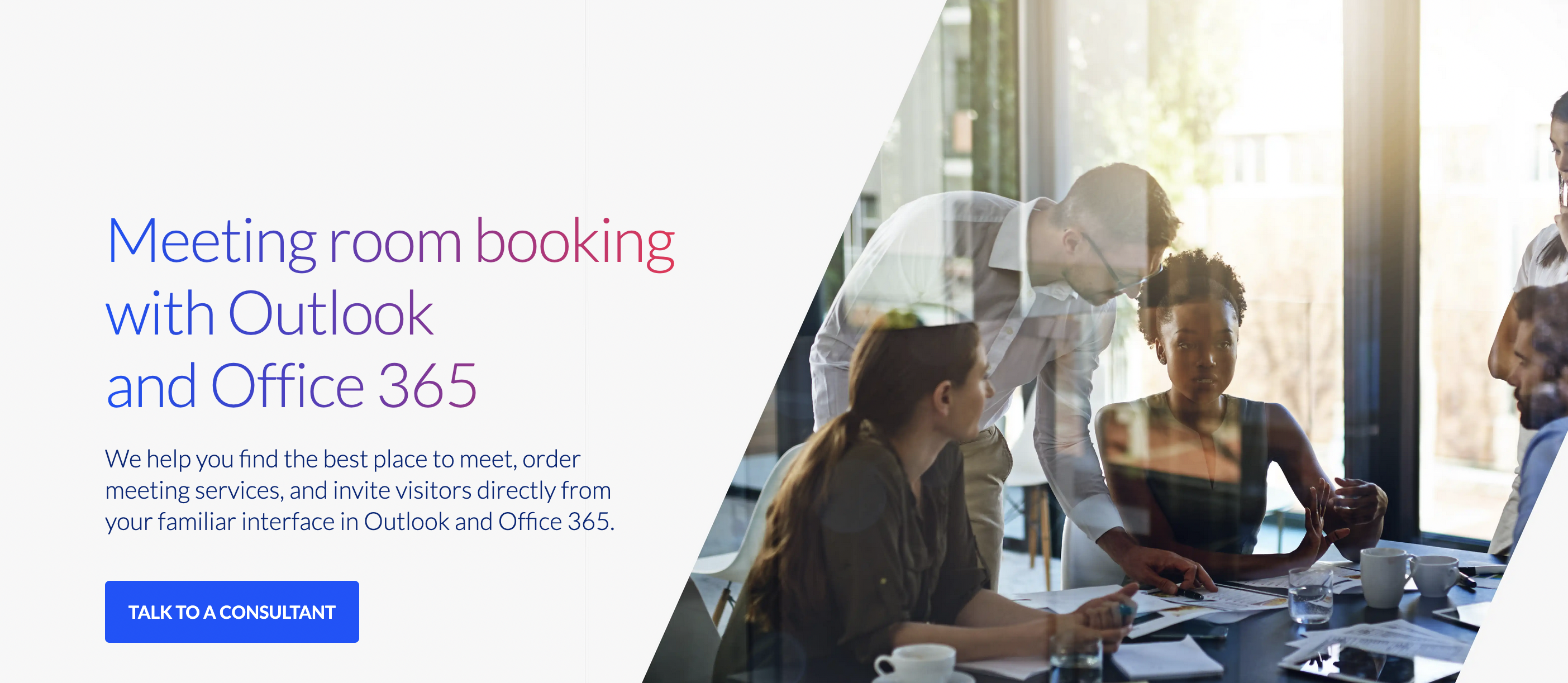
AskCody: meeting room booking with Outlook and Office 365
Feature Highlights
-
Deep Microsoft 365 integration: Works seamlessly with Outlook, Microsoft 365, Exchange, and Teams Rooms, allowing users to book and manage meetings within the tools they already use.
-
Cross-location search: Easily find and reserve meeting rooms, guest offices, or hot desks across multiple locations and time zones.
-
Custom room criteria: Filter rooms by specific amenities, such as whiteboards, cameras, or preferred table arrangements to match every meeting need.
-
Service booking in Outlook: Order catering, equipment, or other meeting services directly from your Outlook interface for a fully connected experience.
-
Room displays and dashboards: Integrated meeting room displays and real-time dashboards show availability, upcoming meetings, and room status across the office for instant visibility.
Best For
AskCody is ideal for organizations deeply embedded in the Microsoft ecosystem - especially those using Microsoft Outlook. It serves corporate offices, professional services firms, or enterprises managing meeting rooms across multiple sites.
Pricing
AskCody’s pricing starts at $4,999/year, including all core features. The base platform fee covers 10 workspaces, 5 rooms, and 1 reception, with the option to add more as needed. Costs scale by organization size and support level, though exact pricing requires a custom quote.
Customer Feedback
Positive: Users praise AskCody as a great platform for creating and managing meeting rooms, noting that it helps optimize booking processes and meeting management. Many appreciate how seamlessly it integrates with Microsoft 365, simplifying room scheduling across large offices.
Negative: Some users mention that customer support can be slow, with tickets occasionally taking time to resolve. Others note that certain features feel limited and the admin interface can be complex for new users, requiring some time to get used to.
| Pros | Cons |
|---|---|
| Seamless integration with Microsoft Outlook and 365 | Customer support response times can be slow |
| Simplifies meeting room booking and management | Admin interface can be complex for new users |
| All-in-one platform with displays, analytics, and visitor management | Some features feel limited in customization |
| Scalable pricing model with all features included | Higher starting price may deter smaller organizations |
AskCody: strengths and limitations
4. Clearooms
Clearooms is a smart meeting room booking software built for smooth, real-time collaboration. Designed to make hybrid workspace management easy, fast, and affordable, it helps teams connect and collaborate.
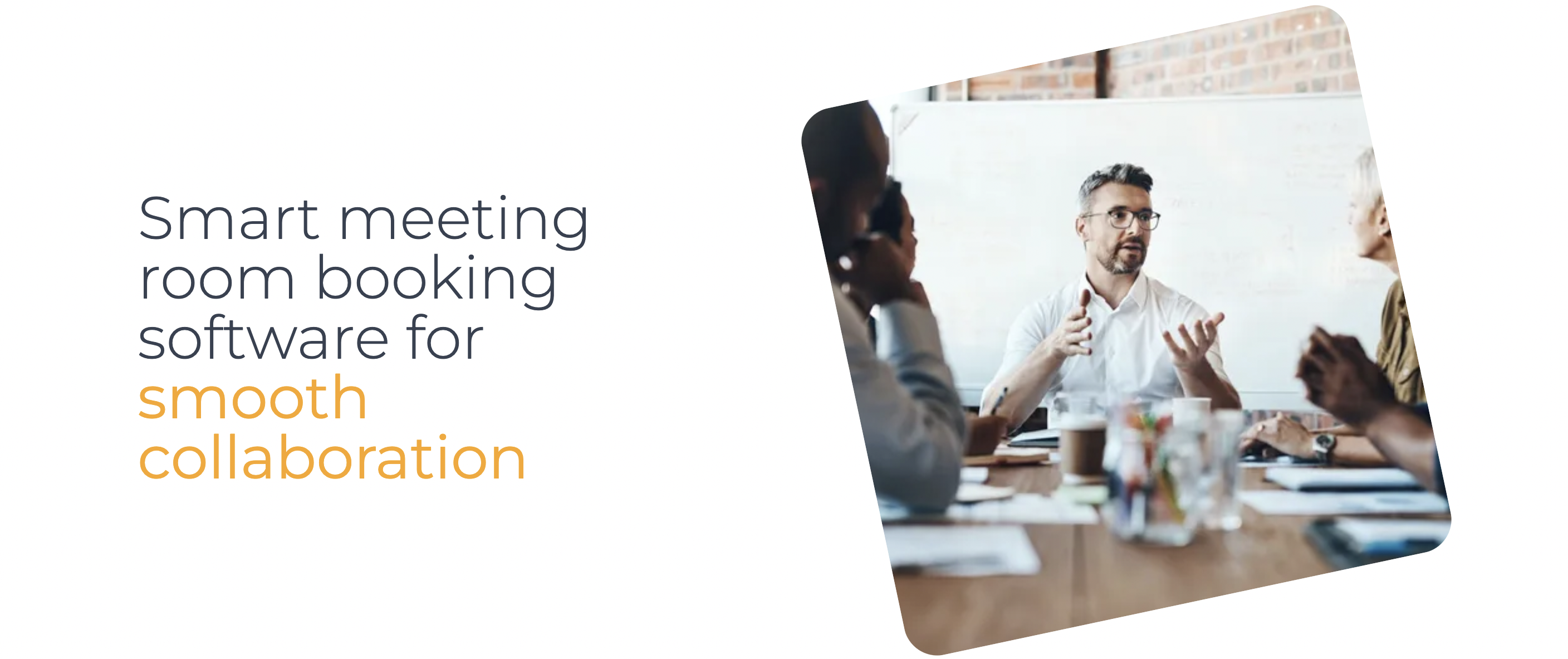
Clearooms: smart meeting room booking software for smooth collaboration
Feature Highlights
-
Quick setup: Get started in minutes - name your office, upload a floor plan, add bookable rooms and desks, and invite employees to begin booking right away.
-
Custom branding: Personalize meeting details and signage with your company’s branding, creating a professional and consistent experience for delegates and departments.
-
Privacy modes: Enable privacy for confidential meetings to hide sensitive details from public room displays or shared calendars.
-
Seamless digital integration: Sync effortlessly with Google Calendar and Outlook for real-time connectivity and smooth scheduling across all platforms.
Best For
Clearooms is best for small to mid-sized businesses looking for an affordable, easy-to-deploy meeting room booking solution. It’s ideal for companies that need quick setup, simple integrations, and user-friendly tools without complex configuration.
Pricing
Clearooms offers flexible monthly pricing with no minimum terms, setup costs, or cancellation fees. Meeting room plans start at $15 per resource per month, and a free trial is available to test the platform before subscribing.
Customer Feedback
Positive: Users appreciate Clearooms for its simple setup, reliable performance, and straightforward pricing. It’s often described as easy to use and well-supported, with smooth implementation and quick integration with Azure AD.
Negative: Some reviewers mention that Clearooms can feel too basic for larger or more complex organizations. Others note slow load times and a lack of broader calendar integrations (such as Apple Calendar), which can affect the overall user experience.
| Pros | Cons |
|---|---|
| Simple, intuitive interface and easy setup | Limited advanced features for complex use cases |
| Straightforward, affordable monthly pricing | Slow load times can affect user experience |
| Reliable performance with good customer support | Lacks integration with Apple Calendar and some other tools |
| Easy implementation and quick adoption | May be too basic for larger organizations |
Clearooms: pros and cons
5. Robin
Robin is a room scheduling platform that simplifies how teams connect and collaborate. It helps employees quickly find and reserve suitable meeting spaces, making the process of organizing and managing meetings smoother and more intuitive.
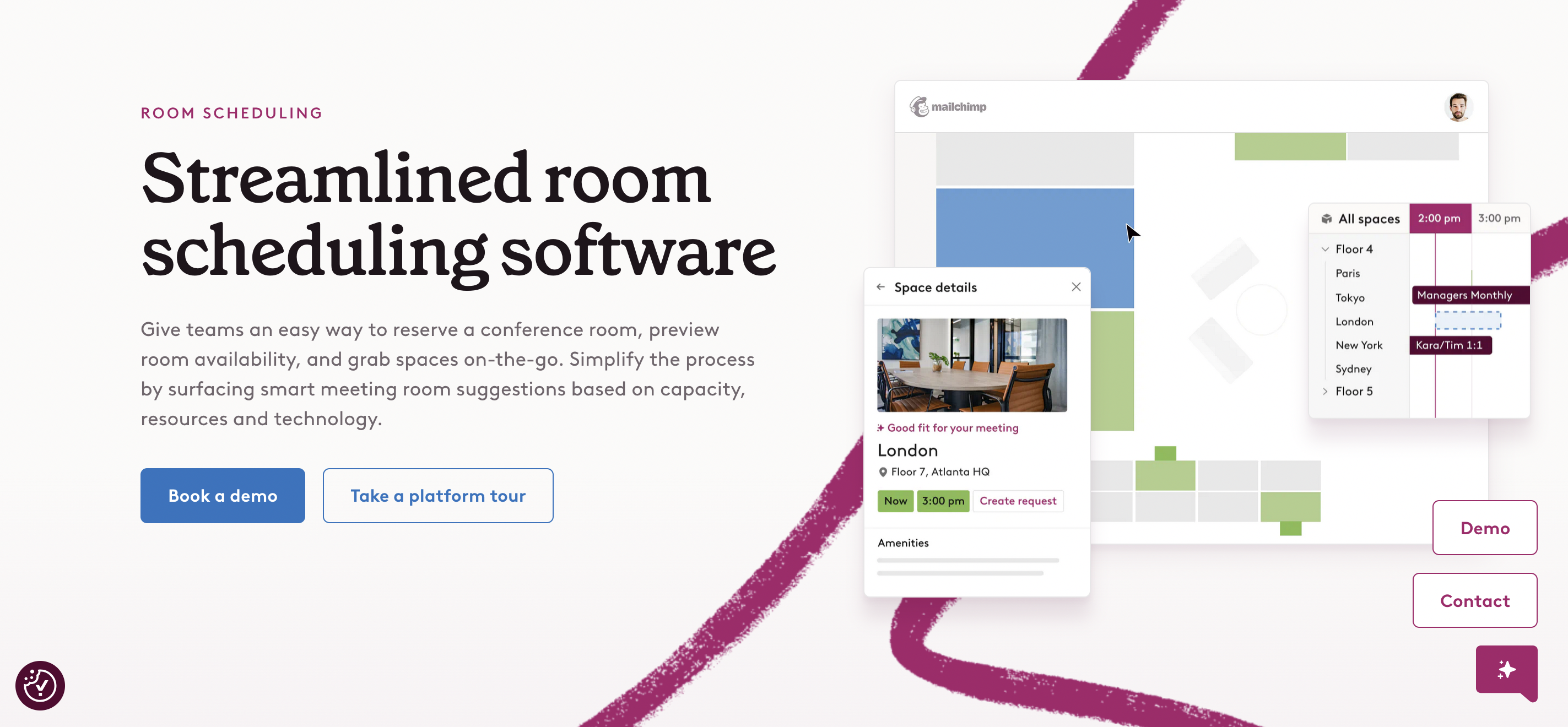
Robin: streamlined room scheduling software
Feature Highlights
-
Space booking policies: Set clear rules for meeting duration, booking windows, and advance reservations to keep scheduling fair and consistent.
-
Smart space matching: Type in the kind of room you need, and Robin automatically suggests spaces based on capacity, layout, and available resources.
-
Mobile app: Book and manage rooms directly from your smartphone, filtering by amenities or size to find the right fit on the go.
-
Slack and Teams integrations: Receive notifications, book rooms, and get smart suggestions directly through Slack or Microsoft Teams.
-
Issue reporting: Employees can report problems with rooms or equipment via desktop, mobile, or QR code, keeping the workspace functional and frustration-free.
Best For
Robin is best for medium to large organizations that want to simplify meeting coordination across multiple locations. It’s especially useful for dynamic offices, where teams need smart room suggestions, mobile access, and seamless integrations with tools like Slack and Microsoft Teams.
Pricing
Robin’s pricing is not publicly listed, which can make cost comparison with other room booking platforms challenging. Interested organizations need to request a custom quote based on their office size, number of spaces, and specific feature requirements.
Customer Feedback
Positive: Many highlight how easy it is to manage rooms and see what each one offers, noting that Robin's graphical layout and smooth UX make it simple for staff to navigate. Reviewers also appreciate how Robin integrates room booking, desk scheduling, parking, and calendars into one end-to-end workplace experience.
Negative: Some users mention that the mobile app can feel clunky and that minor bugs - like inaccurate dashboards or time display issues - occasionally affect usability. Others note that certain Outlook integrations and extra features could be more polished, suggesting the platform should focus on refining its core room booking experience.
| Pros | Cons |
|---|---|
| Intuitive, user-friendly interface with great UX | Mobile app can feel clunky at times |
| Frequent updates and ongoing improvements | Occasional bugs and dashboard inaccuracies |
| Clear graphical room layout and easy navigation | Some Outlook integrations can be unreliable |
| Strong calendar, desk, and parking integrations for a unified experience | Many secondary features that need refinement |
Pros and cons of Robin
6. DeskFlex
DeskFlex offers an AI-powered room scheduling system that streamlines how teams reserve and manage meeting spaces. Its intelligent automation and calendar sync create a smoother, more efficient workplace experience.
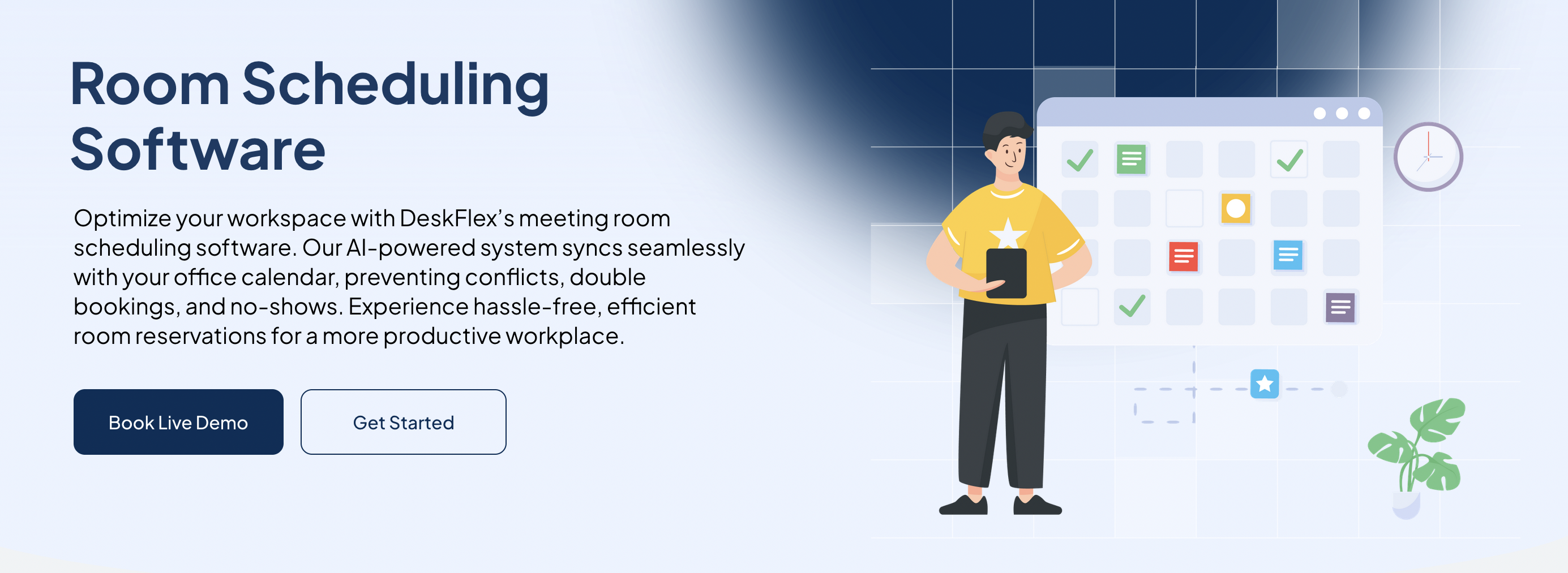
DeskFlex room scheduling software
Feature Highlights
-
Open-source reservation calendar: Enables real-time collaboration, allowing teams to share schedules and coordinate meetings effortlessly.
-
Automated notifications: Sends instant text or email alerts for bookings, reminders, and changes to keep everyone informed and on time.
-
Usage analytics: Tracks room utilization and booking patterns to help organizations make data-driven decisions and improve workspace policies.
-
Interactive maps: Lets employees easily check room availability, prevent scheduling conflicts, and navigate office spaces through visual floor layouts.
Best For
DeskFlex is ideal for enterprises, businesses, government organizations, educational institutions, healthcare facilities, and call centers that need a flexible, centralized system to manage room reservations, resources, and space usage efficiently.
Pricing
DeskFlex does not publicly list its pricing, which can make cost comparison difficult for prospective buyers. However, it does offer a free 30-day trial, allowing organizations to explore its room scheduling features before committing.
Customer Feedback
Positive: Users find DeskFlex user-friendly and easy to navigate, praising its interactive floor maps and clear room layout. Many note that it simplifies conference room management and reduces administrative work - one reviewer mentioned it “made the receptionist’s job much easier” by automating scheduling and space coordination.
Negative: Some users report issues with the mobile app, mentioning crashes, slow performance, and difficulty opening maps. Others note that most employees prefer using the web version instead, suggesting the mobile experience could be improved for better adoption.
| Pros | Cons |
|---|---|
| User-friendly interface and easy navigation | Mobile app may crash or lack full functionality |
| Interactive floor maps for rooms and desks | Pricing not publicly available |
| Helps reduce scheduling conflicts and simplify resource management | Limited customer reviews compared to other solutions, suggesting smaller market adoption |
DeskFlex: pros and cons overview
7. Nexudus
Nexudus is a flexible co-working management platform that helps organizations manage shared spaces more efficiently. It streamlines meeting room and desk reservations with built-in scheduling and check-in tools, making it easier to organize workspaces and support growing communities.
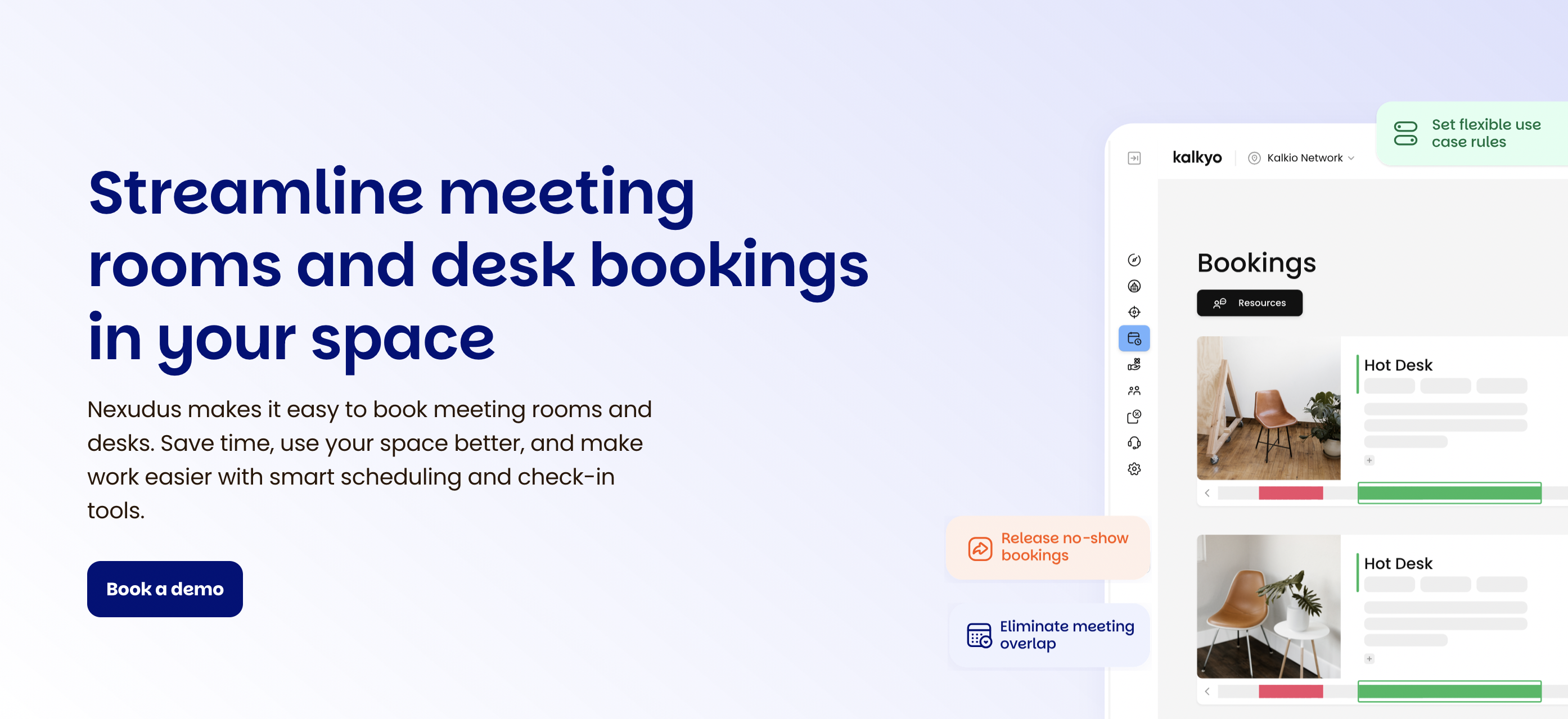
Nexudus: streamline meeting room bookings in your co-working space
Feature Highlights
-
Custom booking rules: Configure policies for cancellations, no-shows, and time limits to ensure fair and efficient use of resources.
-
Granular access controls: Set specific booking permissions by team or individual to manage access and prioritize certain users or member types.
-
Dynamic pricing: Automatically adjust room rates based on demand, time of day, or membership level for optimal utilization.
-
Meeting room demand forecasting: Use data to predict future demand, helping operators balance pricing and availability.
-
Heatmaps and utilization reports: Visualize workspace usage and identify high-demand areas to guide better layout and space planning decisions.
Best For
Nexudus is best for co-working spaces, shared offices, and flexible workspace operators who want an all-in-one platform to manage bookings, memberships, and resources. It’s ideal for community-focused environments that need to maximize space efficiency and member experience.
Pricing
Nexudus offers transparent, location-based pricing for its co-working management platform. The Co-working Professional plan starts at $150 per month per location, including all core features. For spaces with over 500 active users, custom Co-working Growth plans are available upon request.
Customer Feedback
Positive: Users value Nexudus for its efficient support and aftercare, praising the team’s responsiveness and problem-solving approach. The admin interface is appreciated for its clear visuals, and many highlight the white-label app as a strong branding advantage. Overall, users find the platform user-friendly and easy to navigate once familiar with it, often noting it as a dependable tool they use daily.
Negative: Some reviewers mention a steep learning curve during setup and configuration, noting that it takes time to understand all available features. Others point out limited financial reporting, along with occasional bugs or glitches that can slow down daily operations.
| Pros | Cons |
|---|---|
| Efficient, responsive customer support and aftercare | Steep learning curve for new users |
| Clean, visual admin interface | Limited financial reporting capabilities |
| White-label app supports custom branding | Occasional bugs and glitches affect daily use |
| User-friendly navigation once configured | Initial setup and configuration can be time-consuming |
Nexudus: strengths and limitations
8. Tactic
Tactic is a meeting room booking system designed to take the stress out of scheduling. It helps teams quickly find and reserve available spaces, sync calendars seamlessly, and automatically free up unused rooms - keeping collaboration simple and efficient.
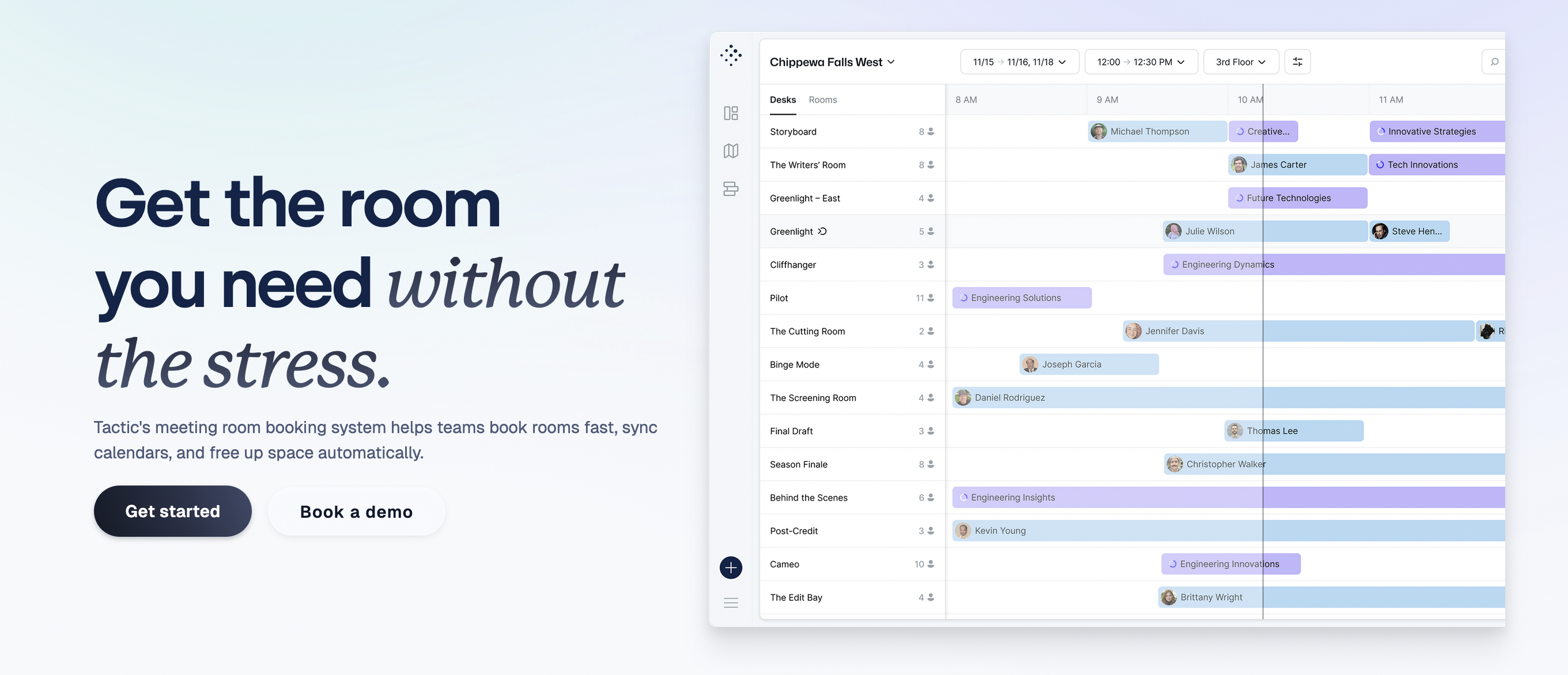
Tactic: get the room you need without the stress
Feature Highlights
-
Smart workplace search & filters: Quickly find available conference rooms by location, team area, or favorite amenities.
-
Flexible booking: Reserve rooms for yourself, your team, or others in just a few seconds, making scheduling effortless and collaborative.
-
Calendar sync: Automatically syncs room reservations to your calendar to prevent double-booking and scheduling surprises.
-
Reminders & release logic: Sends friendly reminders to prevent no-shows and automatically frees unused rooms, keeping the office running efficiently.
-
Delegated booking: Allows managers or admins to book rooms on behalf of others, with customizable rules to ensure fairness and consistency.
-
Real-time insights: Provides data on meeting room usage and booking trends, helping teams plan smarter and optimize workplace performance.
Best For
Tactic is ideal for modern offices and growing teams that want a fast, intuitive room booking system to simplify scheduling and make better use of shared spaces.
Pricing
Tactic does not list its meeting room management pricing publicly, which means interested organizations must contact the vendor for a custom quote.
Customer Feedback
Positive: Users appreciate Tactic’s intuitive interface, real-time scheduling, and helpful reporting features, noting that it makes workspace booking simple and efficient. Many highlight its clean design, easy integration, and responsive customer support, describing the overall experience as smooth and employee-friendly.
Negative: Some reviewers mention occasional lag or calendar syncing issues, along with limited customization options. Others note that the mobile app could be more responsive, and performance can slow down under heavier use, though it remains generally reliable.
| Pros | Cons |
|---|---|
| Intuitive interface with real-time availability | Occasional lag and calendar syncing issues |
| Easy integration and smooth onboarding | Limited customization options |
| Helpful reporting and analytics features | Mobile app could be more responsive |
| Excellent, responsive customer support | Performance may slow under heavy use |
Tactic: pros and cons
9. Officely
Officely offers a meeting room booking system designed for simplicity and everyday use. It lets teams find and reserve meeting spaces, check availability, and manage attendees — all directly within Slack and Microsoft Teams.
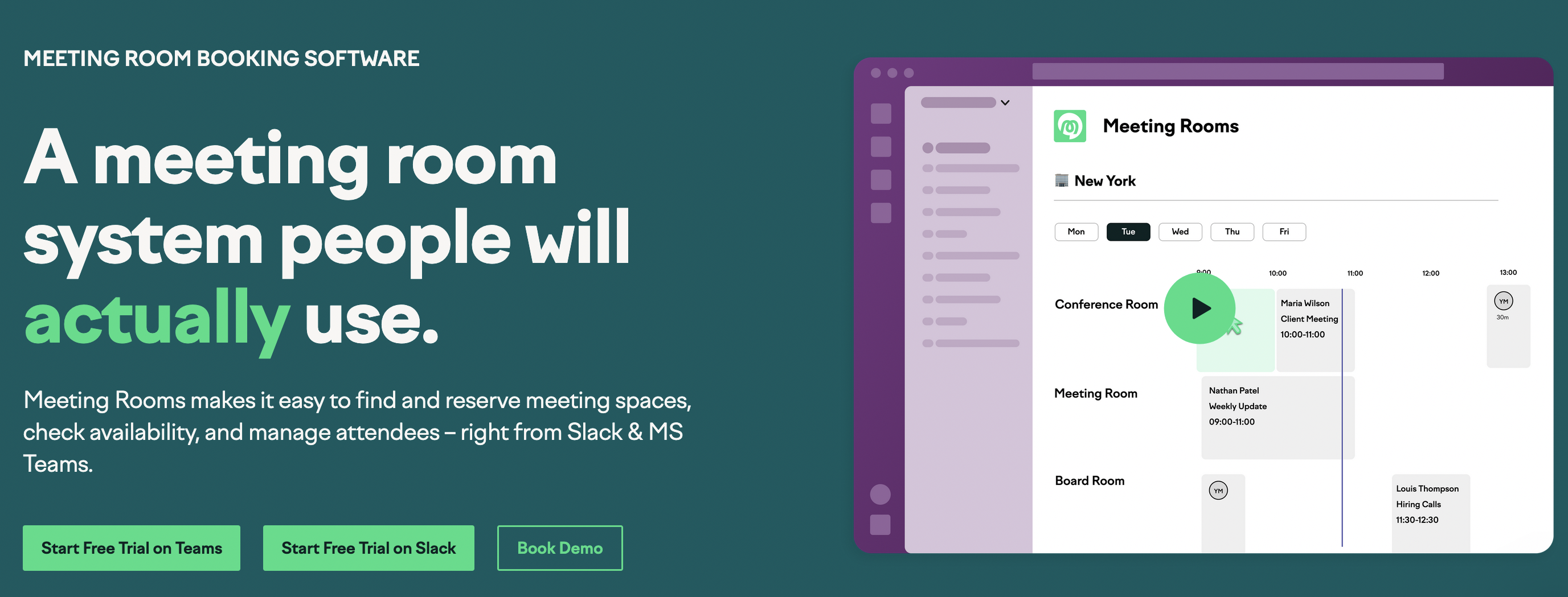
Officely: meeting room booking system for Slack or MS Teams
Feature Highlights
-
Find rooms directly in Slack & Teams: Search, book, and manage meeting spaces without leaving your collaboration tools.
-
Smart room matching: Tag rooms with features like size, equipment, or layout, and let the system automatically suggest the best fit for each meeting.
-
Real-time visibility: Instantly see which rooms are booked or available (and when)
Best For
Officely is best for teams that live in Slack or Microsoft Teams and want a simple room booking solution. It’s ideal for small to mid-sized organizations looking for quick, no-fuss meeting scheduling.
Pricing
Officely’s meeting rooms plan starts at $12 per space per month, allowing teams to manage room bookings directly from Slack and Microsoft Teams. It’s an affordable option for organizations that want an easy, built-in scheduling experience without extra setup.
Customer Feedback
Positive: Users love Officely’s ease of use and quick setup, noting that it integrates seamlessly with Slack and is simple to adopt across teams. Many highlight excellent customer support, with issues resolved quickly and communication described as responsive and helpful.
Negative: Some users mention limited reporting and meeting room analytics, especially for standard users, and note that navigation can feel restrictive at times. However, most agree these are minor limitations once the platform’s workflow becomes familiar.
| Pros | Cons |
|---|---|
| Quick and easy setup with seamless Slack and Teams integration | Limited reporting and no standalone meeting room analytics |
| Simple to adopt across teams | Navigation can feel restrictive at times |
| Excellent, responsive customer support | Fewer advanced features than larger platforms |
Pros and cons of Officely
10. Tidaro
Tidaro is a room and desk booking app built to bring order to flexible workplaces. Its room scheduling system helps teams eliminate wasted time, prevent double bookings, and avoid ghost meetings - creating a smoother, more efficient meeting experience for everyone.
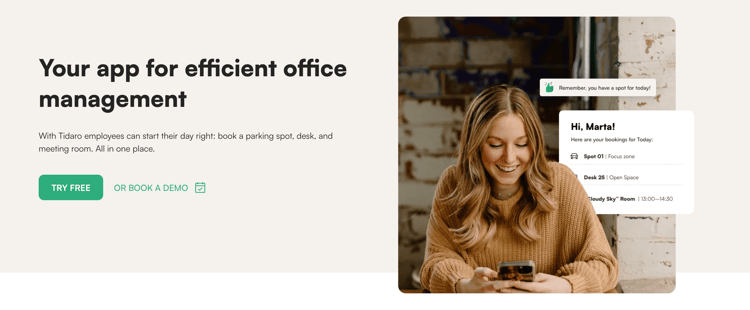 Tidaro room scheduling app
Tidaro room scheduling app
Feature Highlights
-
Automatic Outlook sync: All bookings instantly appear in Microsoft Outlook, ensuring everyone stays aligned without manual updates.
-
Tablet & kiosk mode: Easily enable tablet booking displays to show real-time room availability, helping employees quickly find and reserve open spaces right from the door.
-
Simplified user management: Supports Single Sign-On (SSO) for easy and secure employee access across the organization.
-
Enterprise-grade security: ISO 27001:2022–certified Information Security Management System (ISMS) ensures all workplace and booking data is protected to global standards.
Best For
Tidaro is best for organizations with flexible or activity-based workplaces that want a simple, secure, and Microsoft-friendly room booking system.
Pricing
Tidaro’s Room plan starts at €15 per room/month, covering core booking features like scheduling, ad-hoc reservations, and automatic cancellations. The Room Plus plan costs €20 per room/month and adds tablet view and Outlook integration. A 14-day free trial is available.
Customer Feedback
Positive: Users highlight Tidaro’s ease of use, smooth implementation, and clear interface, noting that it’s reliable and visually intuitive. Many appreciate the quick room changes, easy access, and helpful customer support team, as well as the detailed office maps that make navigation simple.
Negative: Some reviewers mention that the admin interface could be simplified, with certain actions requiring too many clicks. Others report occasional connectivity delays and suggest that color-coded sections or faster list management would further improve the user experience.
| Pros | Cons |
|---|---|
| Easy to implement and very user-friendly | Some admin functions require too many clicks |
| Clear interface with detailed, well-designed office maps | Occasional connectivity delays |
| Reliable performance and responsive customer support | Limited customization (e.g., color coding) |
Tidaro: pros and cons
11. Skedda
Skedda is a conference room booking software that helps teams easily reserve meeting spaces and manage shared resources. Designed to boost collaboration and space efficiency, it offers intuitive scheduling tools that make organizing meetings effortless and transparent.
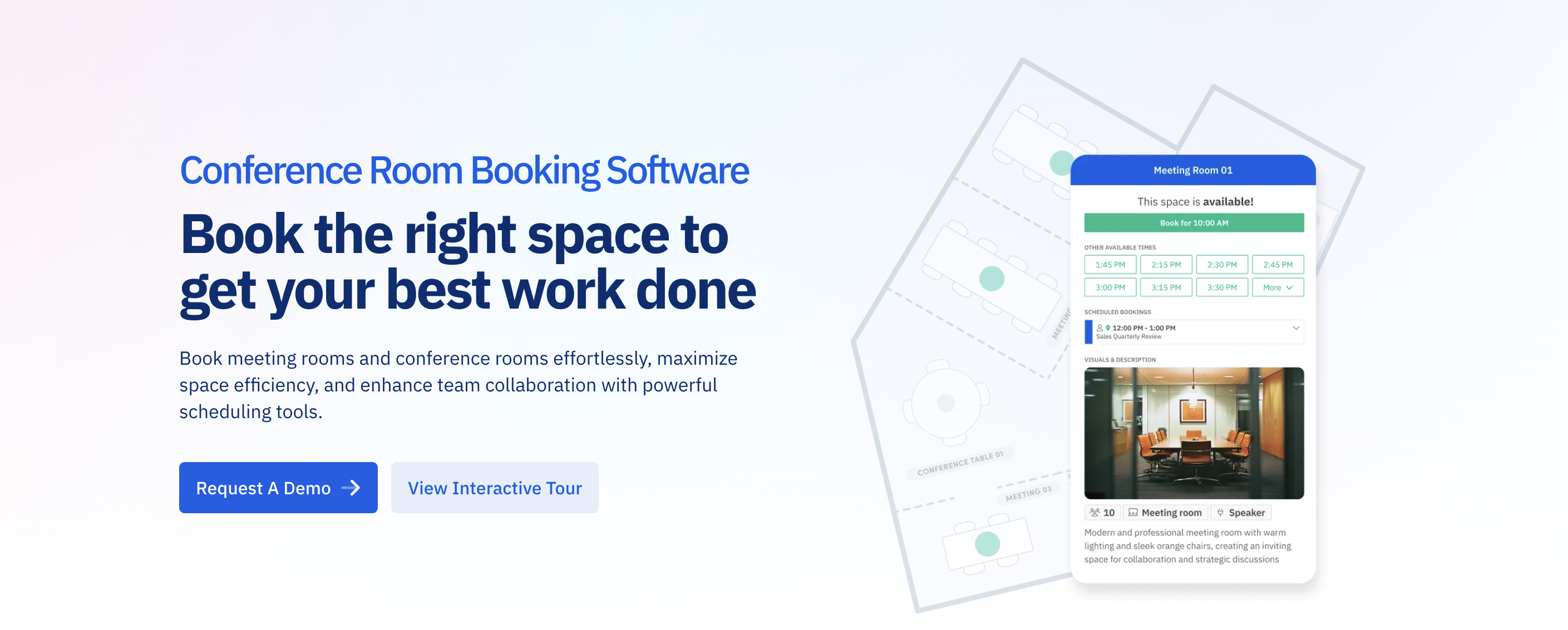
Skedda conference room booking software
Feature Highlights
-
Real-time availability: View open meeting and conference rooms instantly on the Skedda Scheduler or via tablet displays for quick, on-the-spot booking.
-
Check-in system: Secure your reserved space by checking in, preventing no-shows and ensuring rooms are used efficiently.
-
Data-driven insights: Access utilization analytics to see which rooms and amenities are most popular, helping you make smarter space management decisions.
-
Two-way calendar sync: Seamlessly integrates with Microsoft 365, Outlook, and Google Workspace, preventing double bookings and keeping schedules up to date.
-
Booking quotas: Set rules to limit how often individuals or teams can book specific rooms, ensuring fair access for everyone.
Best For
Skedda is best for organizations of all sizes that want a simple yet powerful conference room booking system. It’s particularly useful for offices, coworking spaces, universities, and community hubs that need real-time visibility, fair booking rules, and detailed usage analytics to manage shared spaces efficiently.
Pricing
Skedda’s plans start at $99 per month, with tiers for growing and enterprise needs. Pricing scales based on the number of spaces, starting from 15 in the base plan.
Customer Feedback
Positive: Users praise Skedda for its intuitive, user-friendly interface that makes scheduling and managing spaces effortless. Many highlight the excellent customer service, describing the team as responsive, knowledgeable, and always willing to help.
Negative: Some reviewers mention that pricing could be more affordable and that the visual design lacks consistency, with fonts and color shades that could be more polished for a cleaner, professional look.
| Pros | Cons |
|---|---|
| Intuitive, user-friendly interface | Pricing could be more affordable |
| Excellent, responsive customer support | Visual design sometimes lacks consistency |
| Effortless space scheduling and management | Could be more customizable |
Pros and cons of Skedda
12. Matrix Booking
Matrix Booking is a meeting room booking system built for flexible teams that need quick access to shared spaces and resources. It helps employees easily discover and reserve rooms based on size, location, or available equipment, making workspace coordination simple and efficient.
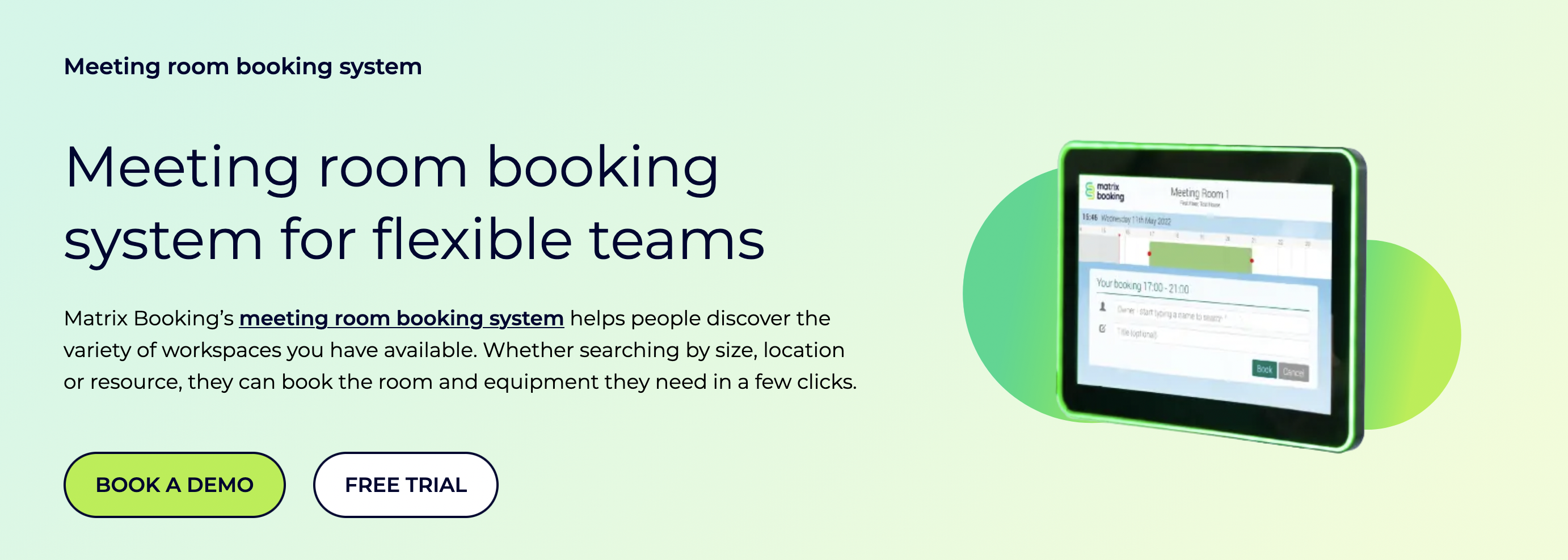
Matrix Booking: meeting room booking system for flexible teams
Feature Highlights
-
Advanced search and filters: Quickly find rooms or workspaces by capacity, facilities, accessibility, and location.
-
Custom room layouts: Choose and request different room setups when booking to ensure the space fits each meeting’s purpose.
-
Resource and catering booking: Add catering, equipment, or other meeting resources directly within the reservation process.
-
Flexible booking options: Book via Outlook, the Matrix Booking mobile or web app, digital room displays, or QR codes for easy, on-the-go scheduling.
Best For
Matrix Booking is best for organizations across both public and private sectors that need a centralized way to manage meeting rooms and shared spaces. It’s widely used in industries such as central and local government, education, legal, utilities, insurance, retail, manufacturing, construction, and others.
Pricing
Matrix Booking does not publicly share its pricing, which can make it difficult for organizations to compare costs with other meeting room booking systems. However, a 14-day free trial is available, allowing teams to test the platform and its core features before committing.
Customer Feedback
Positive: Users describe Matrix Booking’s meeting room system as "extremely simple and intuitive", praising its clear interface and action-oriented design that makes booking rooms fast and straightforward. Many highlight its flexibility and customization options, noting that it easily adapts to different office layouts and evolving workplace needs.
Negative: Some reviewers point out that integrations are limited, and administrators mention that managing user permissions or advanced booking settings can feel cumbersome. Others note that recurring or rules-based bookings are difficult to configure, requiring additional setup time.
| Pros | Cons |
|---|---|
| Simple, intuitive interface that’s easy to navigate | Limited integrations with third-party tools |
| Flexible and customizable to different office layouts | Managing user permissions can be cumbersome |
| Fast, action-oriented booking process | Recurring and rules-based bookings are difficult to configure |
Matrix Booking benefits and limitations
13. Dibsido
Dibsido is a workplace booking app that brings order to shared space management. With a single click, employees can reserve their favorite desks, parking spots, or meeting rooms—eliminating the need for spreadsheets and manual coordination.
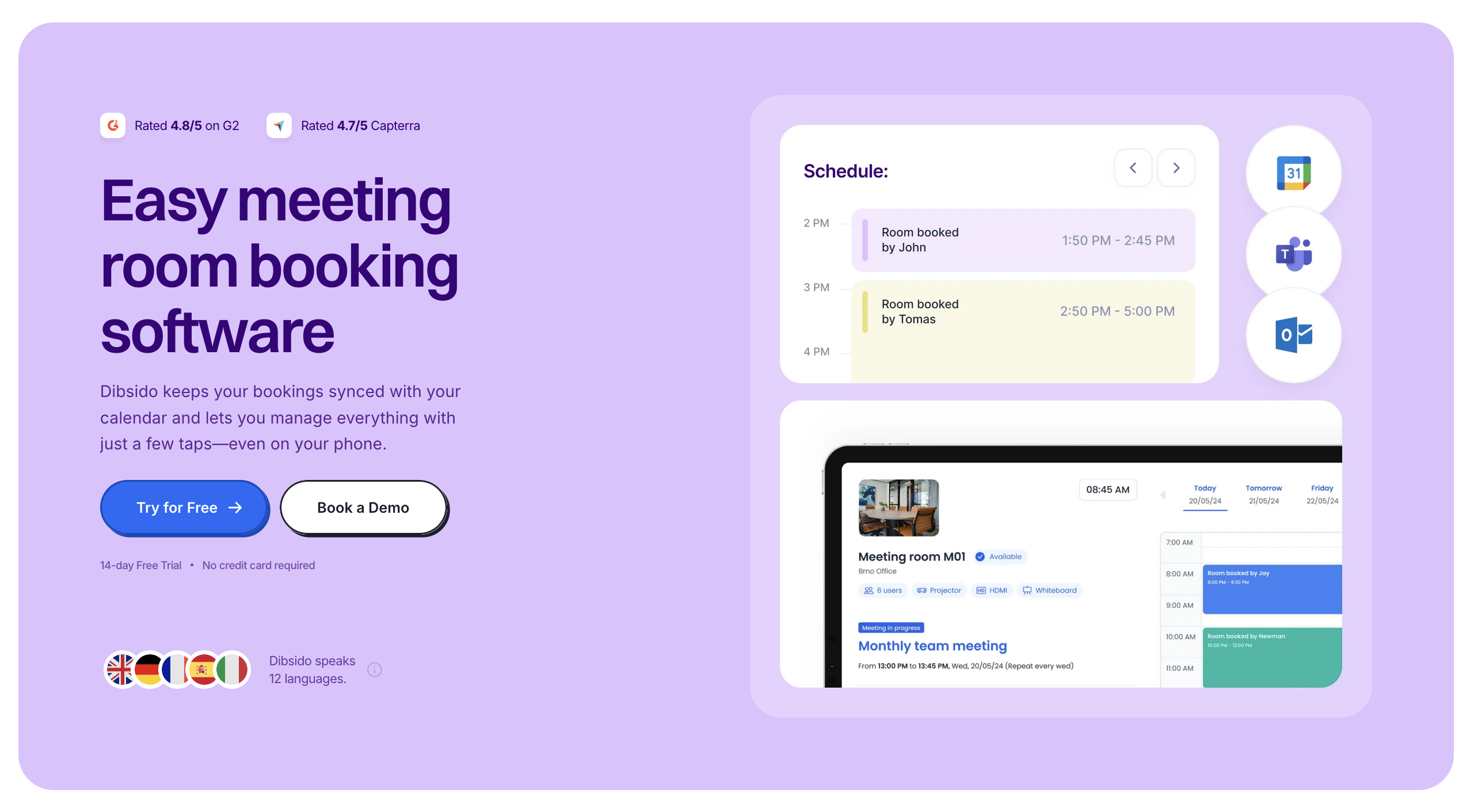
Dibsido: easy meeting room booking software
Feature Highlights
-
One-click bookings: Reserve a meeting room instantly — no forms, no back-and-forth, just one tap to confirm your space.
-
Calendar synchronization: Automatically sync bookings with Google or Microsoft calendars to keep schedules aligned and avoid overlaps.
-
Auto-cancellation: Unconfirmed bookings are automatically released, ensuring no room sits empty and office space is used efficiently.
-
Interactive maps: Find your way easily with intuitive office floor maps that guide you straight to your booked room.
-
Tablet screen booking: Create or confirm bookings directly from tablets mounted outside meeting rooms.
-
Mobile app: Manage reservations anytime, anywhere through the Dibsido mobile app for iOS and Android.
Best For
Dibsido is best for small to mid-sized hybrid offices looking for a simple, fast, and visual room booking system. It’s ideal for teams that want quick one-click reservations, automatic calendar sync, and easy navigation through interactive office maps.
Pricing
Dibsido offers a free plan for small teams with one meeting room, a Business plan starting at €7 per room/month for growing organizations, and custom Enterprise plans for larger companies needing advanced security and controls.
Customer Feedback
Positive: Users praise Dibsido’s intuitive booking process and clear dashboard that displays all key information at a glance. Many highlight the excellent customer support, noting that the development team is highly responsive and attentive to client needs.
Negative: Some reviewers mention limited integration with Microsoft Teams and note that mobile navigation could be smoother. Admins also suggest adding more analytics and reporting features to enhance workspace insights.
| Pros | Cons |
|---|---|
| Clear, easy-to-navigate dashboard | Limited integration with Microsoft Teams |
| Intuitive booking process | Mobile navigation could be improved |
| Responsive, customer-focused support team | Lacks advanced analytics and reporting features |
Dibsido: pros and cons overview
14. Smartway2
Smartway2 by Hubstar is a meeting room booking system designed to make in-person collaboration easier and more effective. It streamlines scheduling, helps rebuild social connection in the workplace, and uses advanced analytics to optimize room utilization, reduce costs, and lower environmental impact.
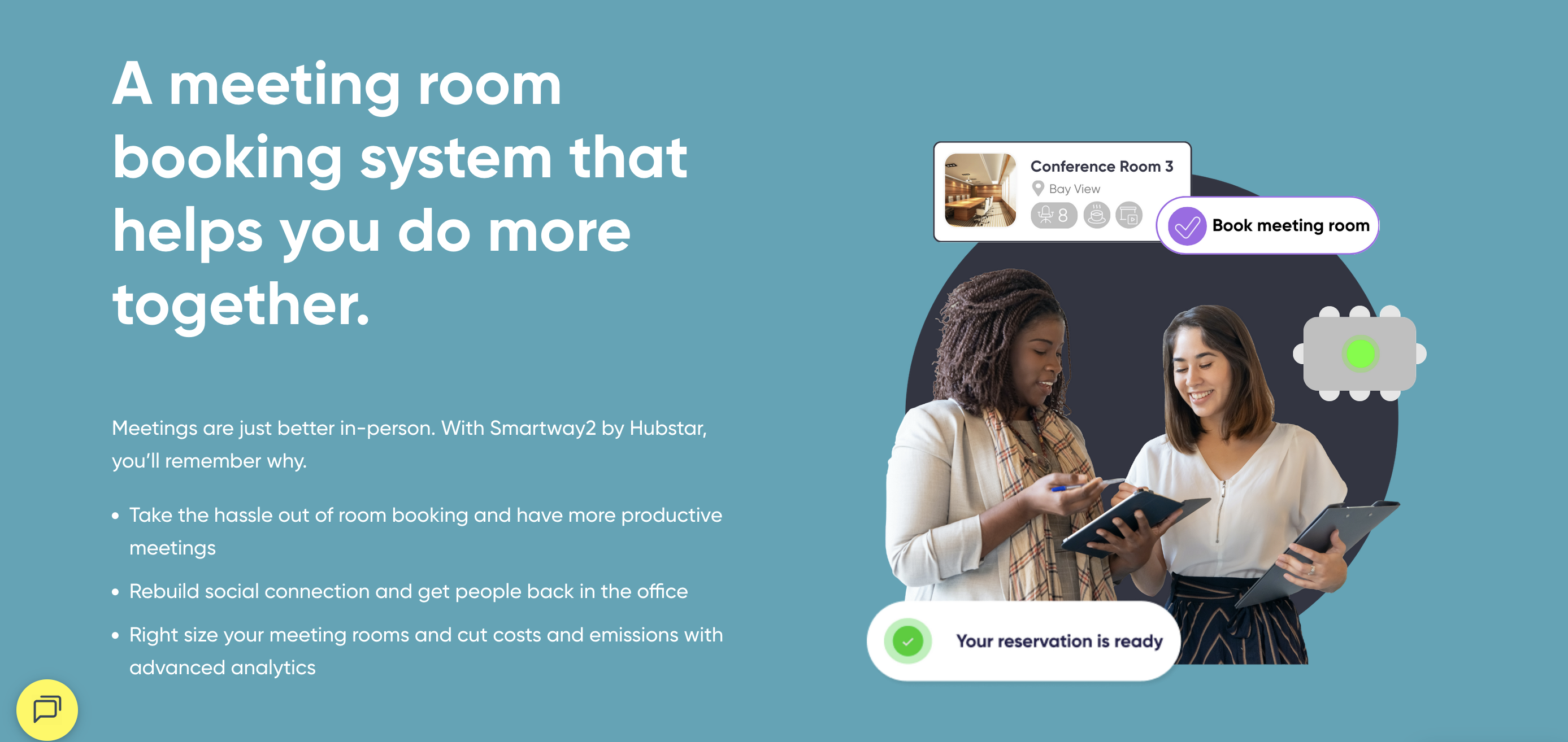
Smartway2 by Hubstar: a meeting room booking system that helps you do more together
Feature Highlights
-
Smart room recommendations: Get instant suggestions for rooms that match your size, layout, and equipment needs.
-
Integrated services: Add catering, cleaning, or other resources directly when booking, with automated approvals and notifications.
-
Easy booking: Reserve rooms or recurring meetings from Outlook, the web, mobile app, or display panels in just a few clicks.
-
Actionable analytics: Track usage, no-shows, and room popularity to optimize layouts, cut costs, and reduce wasted space.
Best For
Smartway2 is best for medium to large organizations that want to simplify in-person meeting scheduling while improving space efficiency. It’s ideal for companies focused on optimizing how meeting rooms are used across multiple locations.
Pricing
Smartway2 doesn’t publish detailed pricing on its website, making direct cost comparisons difficult. Interested organizations must request a tailored quote to explore annual subscription options.
Customer Feedback
Positive: Users find Smartway2 easy to use and appreciate its single sign-on access and clear room availability views. The ability to include setup notes and requirements during booking is seen as a major convenience. Many also highlight the meeting room panels as a big improvement for day-to-day room management.
Negative: Some users mention occasional glitches, such as meetings saving with the wrong duration or challenges during initial Outlook integration. While support is responsive for quick fixes, complex issues can take longer to resolve. A few note that the system can be confusing without proper training.
| Pros | Cons |
|---|---|
| Easy-to-use interface with clear room availability | Occasional glitches with meeting duration or syncing |
| Convenient single sign-on and setup options | Outlook integration can be tricky to implement |
| Helpful meeting room panels for on-site management | Requires proper training to avoid user confusion |
Smartway 2: strengths and limitations
15. Roomzilla
Roomzilla is a resource management platform that helps organizations manage rooms, desks, and equipment all in one place. It simplifies reservations, automates scheduling, and tracks usage to improve efficiency. Whether booking meeting rooms, hot desks, or specialized tools, Roomzilla provides a flexible, all-in-one solution for smarter workplace and resource management.

Roomzilla: workplace resource management platform
Feature Highlights
-
Room management: Reserve and optimize meeting spaces with automated scheduling, real-time tracking, and detailed usage reports to improve resource allocation.
-
Desk booking: Manage hot desks seamlessly to support flexible work arrangements. Employees can book desks on-demand or in advance for efficient space utilization.
-
Equipment and resource booking: Manage a wide range of resources - from lab tools and AV equipment to parking spots and office furniture - all in one system.
-
Room displays: Use digital displays outside meeting rooms to check availability, view upcoming bookings, or reserve spaces instantly.
-
Interactive maps: Navigate the workplace easily with interactive floor maps that show available rooms, desks, and resources in real time.
-
Automation and insights: Simplify scheduling and access powerful usage analytics to make data-driven space management decisions.
Best For
Roomzilla is best for organizations of all sizes that need a centralized platform to manage rooms, desks, and shared resources. It’s especially useful for coworking spaces, offices, universities, and research facilities looking to streamline bookings, improve utilization, and simplify day-to-day workspace management.
Pricing
Roomzilla offers a free plan for up to 3 resources, with paid plans starting at $12 per resource/month. A 14-day free trial is available, and discounts apply for larger accounts.
Customer Feedback
Positive: Users praise Roomzilla for its intuitive visual floor plans and real-time room availability, which make finding and booking meeting spaces effortless. The tablet displays showing remaining meeting time and upcoming reservations are particularly appreciated. Many note that it has significantly improved space management and simplified daily scheduling.
Negative: Some users find the mobile experience lacking due to the absence of a dedicated app, relying instead on a less responsive mobile website. Others mention that initial setup can be complex, customization options are limited, and cancellation syncing can occasionally lag. Pricing may also feel high for smaller teams, with advanced analytics reserved for higher-tier plans.
| Pros | Cons |
|---|---|
| Intuitive visual floor plans and real-time availability | No dedicated mobile app; web version can be frustrating |
| Easy, seamless booking process | Setup can be complex and may require IT support |
| Helpful in-room tablet displays showing live booking details | Occasional syncing delays across platforms |
| Improves overall office space management | Higher-tier pricing and limited customization options |
Pros and cons of Roomzilla
16. Kadence
Kadence helps teams easily find and reserve the right meeting spaces. Designed to maximize workspace use, it streamlines room booking so employees can spend less time scheduling and more time collaborating productively.
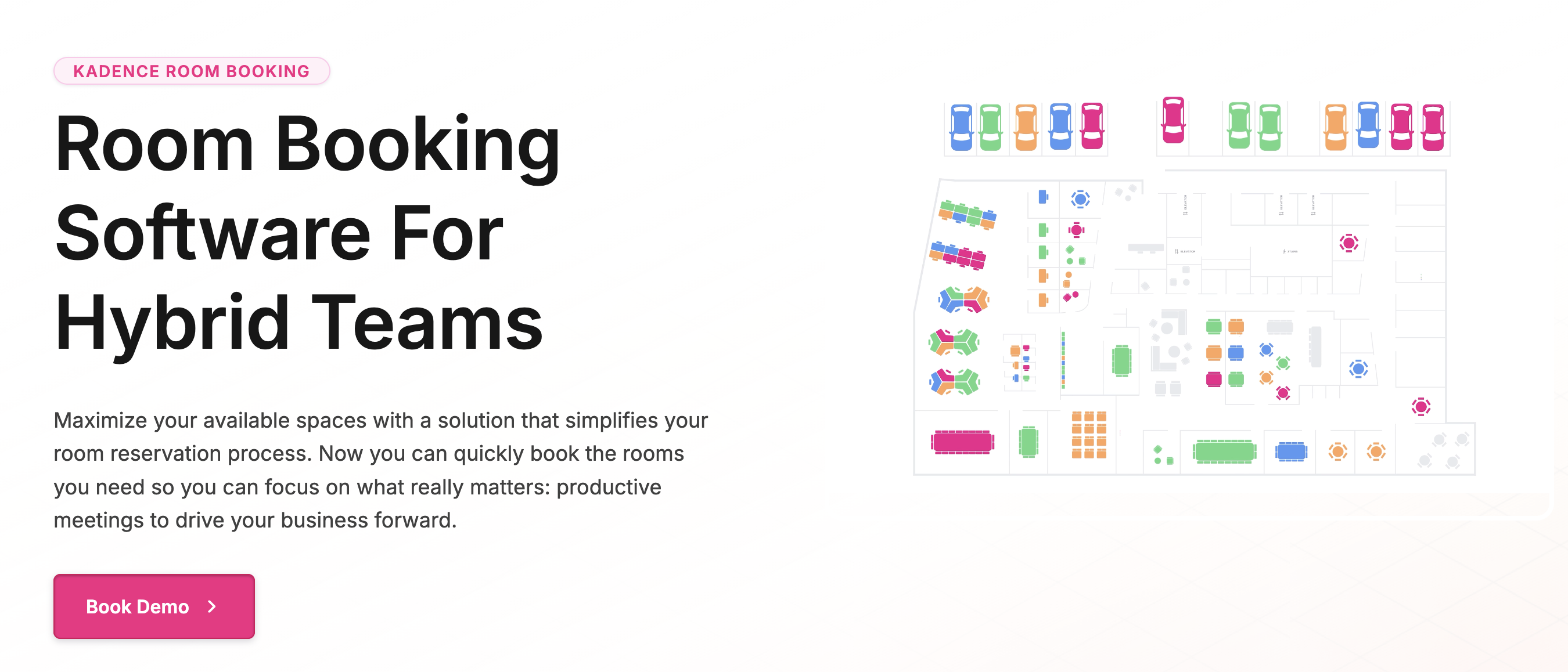
Kadence: room booking software for hybrid teams
Feature Highlights
-
Quick book: Instantly find and reserve available meeting rooms for the exact time you need.
-
Meeting room visibility: View all room availability in one centralized dashboard for easier planning.
-
Live usage data: Monitor real-time room utilization to understand how spaces are being used.
-
Conference room amenities: Add details like equipment, capacity, and layout to match team needs.
-
Auto-release: Automatically free up rooms when bookings are cancelled or go unused.
-
Catering integration: Include catering requests directly when reserving a room.
-
Check-in reminders: Get instant notifications to confirm attendance and reduce no-shows.
-
Advanced booking: Set booking windows to allow teams to schedule meetings in advance while maintaining control over availability.
Best For
Kadence is best for modern, flexible teams that want a simple yet powerful room booking system. It’s ideal for organizations looking to maximize meeting room utilization, reduce no-shows, and streamline collaboration through real-time visibility and automation.
Pricing
Kadence’s Standard and Enterprise pricing plans are not publicly disclosed. Interested organizations must contact the Kadence team directly for a tailored quote.
Customer Feedback
Positive: Users appreciate Kadence for its user-friendly interface, quick setup, and responsive technical support. Many highlight how easy it is to navigate, track where colleagues are located, and manage room bookings across the workspace. The support team is praised for its fast response times and helpful guidance during setup and troubleshooting.
Negative: Some reviewers mention occasional glitches when changing bookings and note that certain edits can be difficult without support assistance. Others report that integrations can feel clunky and require broad calendar access, which may complicate implementation.
| Pros | Cons |
|---|---|
| User-friendly interface that’s easy to learn | Occasional glitches when modifying bookings |
| Quick setup with helpful, responsive support | Some edits require assistance from the support team |
| Makes it easy to see where colleagues are located | Integrations can be clunky and complex |
Benefits and limitations of Kadence
Other Conference Room Booking Systems
We’ve covered 16 of the best meeting room booking systems in this guide - but the market is much broader and continues to evolve rapidly. To help you explore beyond the leading platforms, we’ve also compiled a list of additional solutions offering various features, integrations, and industry specializations. This extended list gives you a wider view of the room booking software landscape and helps identify the best fit for your organization’s unique needs:
- Ronspot - a simplified meeting room booking system that helps teams quickly see room availability, reserve spaces, invite colleagues, and manage bookings on the go.
- ROOMZ - a meeting room booking system that combines wireless room displays, occupancy sensors, and analytics tools.
- Smart Spaces - a conference room booking system that simplifies the management of rooms, desks, and shared spaces.
- Hybo - meeting room management software that helps teams easily reserve rooms and manage office spaces efficiently.
- Joan - a meeting room booking solution that lets you instantly check room availability and reserve spaces in seconds. It helps eliminate ghost meetings, prevent scheduling conflicts, and make meeting coordination effortless.
- Envoy - room and resource booking software that helps teams easily find and reserve the right space while freeing up unused rooms for better workplace efficiency.
- Archie - room scheduling software that simplifies meeting room bookings and helps teams plan and organize meetings without the usual chaos.
- Eptura Engage (formerly Condeco) - an AI-powered room and desk booking solution that helps employees make the most of their office time while enabling workplace leaders to manage, streamline, and optimize space utilization across the modern workplace.
- Workero - a conference room booking system that enhances collaboration by providing a seamless, easy-to-use workplace solution for reserving and managing meeting spaces.
- Akurlee - a next-generation meeting room booking system that makes it easy to schedule, reserve, and manage meeting and conference rooms quickly and intelligently.
- Logitech Room Booking (formerly Meetio) - a simple room scheduling solution that streamlines meeting room management and makes it easy for employees to find and book available rooms quickly.
- Whatspot - a smart meeting room booking system that makes it easy to find and reserve the right space in seconds.
- Korbyt - room reservation software that enhances productivity, promotes teamwork, and helps organizations optimize their physical workspaces through simple, effortless room scheduling.
- Spaceti - a room booking tablet app that provides a comprehensive, real-time solution for reserving meeting spaces.
- Eden - a conference room scheduling software that makes it easy for employees to book meeting rooms on demand. It also allows admins to manage room capacities, floor plans, and amenities, while tracking usage and booking metrics.
- WorkInSync - intelligent meeting room booking software that simplifies room management, helping teams schedule and organize meetings effortlessly - without the usual hassle.
- Bookings One - an all-in-one smart office system that helps organizations adapt to hybrid work, improving workplace efficiency, competitiveness, and overall company image.
- Zoho - offers a conference room management software that lets employees easily find and reserve rooms from a mobile app.
- SuperSaaS - a free meeting room booking system that allows teams to easily customize and manage room reservations to fit their needs.
What's Next? Meeting Room Booking Tech Trends for 2026
The meeting room booking technology market is entering a new phase of rapid innovation and expansion. As organizations refine their hybrid work strategies, demand for smart, AI-powered, and sustainable booking systems is expected to surge. Heading into 2026, these solutions will sit at the heart of every connected workplace - optimizing space, reducing waste, and making collaboration more seamless than ever.
AI and Automation
In 2026, AI-driven room scheduling will shift from early adoption to an everyday standard. Modern systems already use predictive algorithms to anticipate room demand, suggest ideal spaces, and automate reservations.
A glimpse of this future is visible in YAROOMS’ AI assistant, YARVIS, which lets employees instantly book meeting rooms in Microsoft Teams or Slack, recommends spaces based on meeting needs, and automatically adjusts or releases bookings if plans change.

YARVIS AI workplace assistant
Deeper Integration with Communication Tools
In 2026, seamless interoperability will define the next wave of meeting room booking technology. Nearly 70% of organizations are actively seeking to implement or upgrade meeting room booking systems that offer improved interoperability with communication and calendar systems.
Because of that, platforms will merge even more tightly with Microsoft 365, Google Workspace, Slack, and Zoom, enabling users to book, join, and manage meetings without ever leaving their preferred tools. This unified experience will finally blur the line between in-person and virtual collaboration, keeping hybrid teams connected and productive wherever work happens.
Real-Time Analytics and Space Optimization
Advanced workplace analytics are quickly becoming a core component of modern room booking systems. Platforms like YAROOMS, Robin, or Kadence already provide real-time dashboards that track occupancy trends, no-shows, and utilization rates, helping organizations make smarter, data-driven decisions.
As we move into 2026, these analytics will go even further - combining insights from sensors and smart building data to optimize capacity, improve space efficiency, and reduce real estate costs. The result: a clearer view of how every room is used and a measurable boost in ROI.
Cloud and Mobile Flexibility
Cloud-based and mobile-first meeting room booking systems are redefining how employees interact with the workplace. They enable users to book, check in, or modify reservations from anywhere - through a smartphone, kiosk, or digital display. This level of accessibility supports dynamic hybrid work models, allowing organizations to allocate space based on real-time needs rather than static schedules.
Resources and Further Reading
The insights in this guide are based on a combination of trusted sources, including:
-
Official vendor websites (product, pricing, and feature documentation)
-
Independent review platforms like G2, Capterra, Gartner Peer Insights, and SourceForge
-
User discussions from professional communities and workplace tech forums
-
Industry publications such as peoplemanagingpeople.com and other workplace technology resources
Keep in mind that the meeting room booking software market continues to evolve — with new features, pricing updates, and integrations released regularly. For the most accurate and up-to-date details, always refer to each vendor’s official website.
For more guidance on choosing the right meeting room booking system, check out these articles:
- Meeting Room Management with YAROOMS Booking Software
- 10 Benefits of a Meeting Room Booking System
- How to Create a Winning Meeting Room Policy: A Step by Step Guide
- Why Meeting Room Analytics Matter in Today’s Office
- How to Prevent Double Bookings in Meeting and Conference Rooms
- Digital Meeting & Conference Room Signage: 5 Use Cases
- Conference Room Technology: The Essential Guide
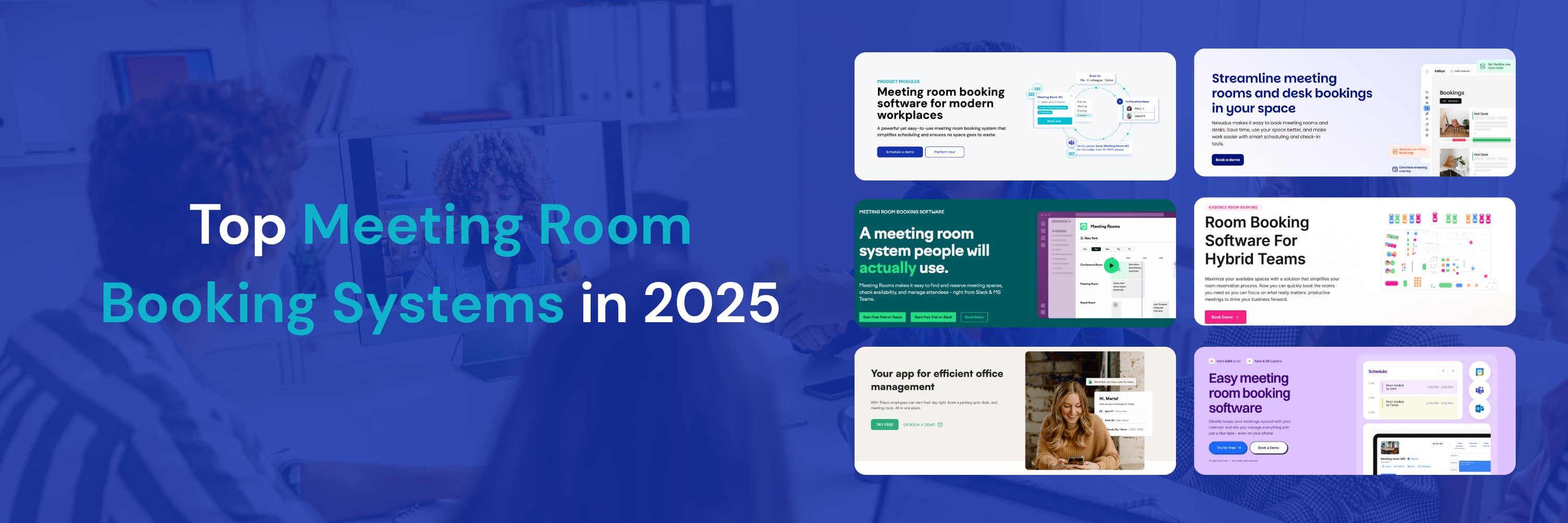

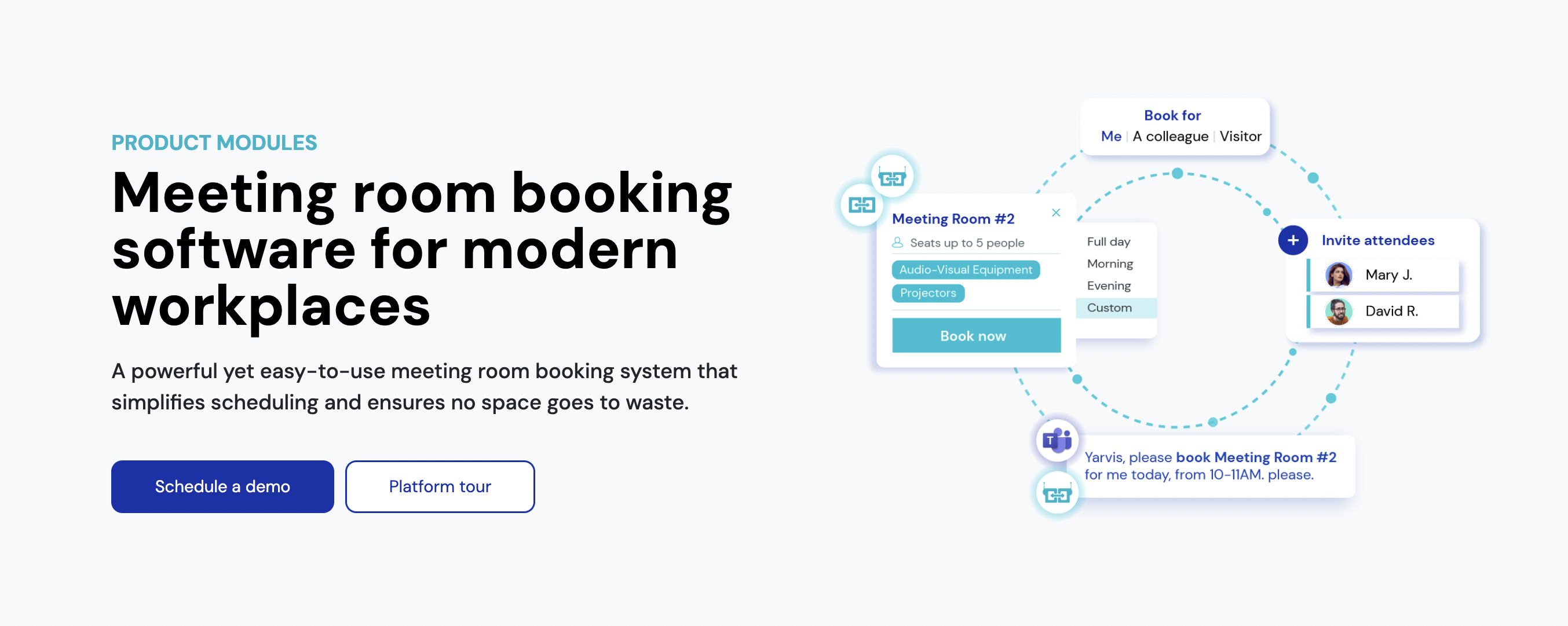
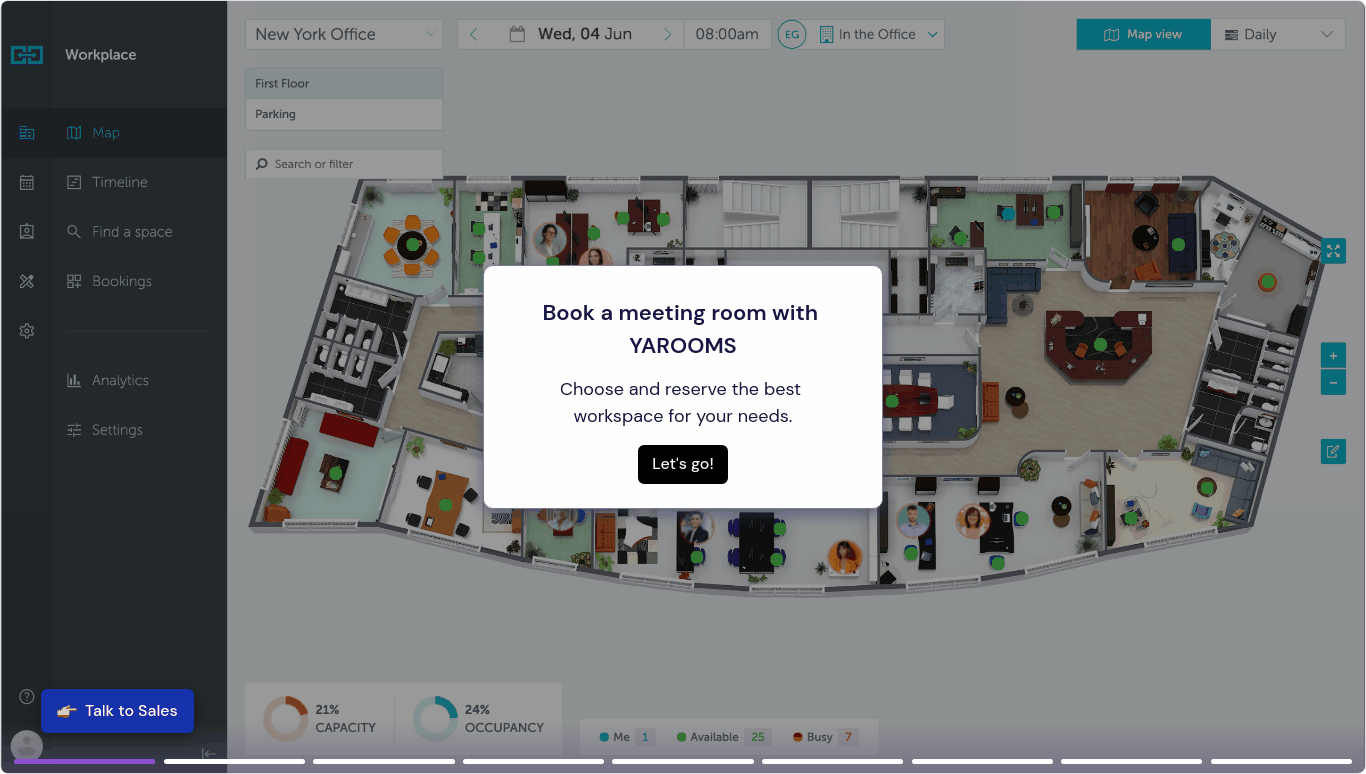
.png)









